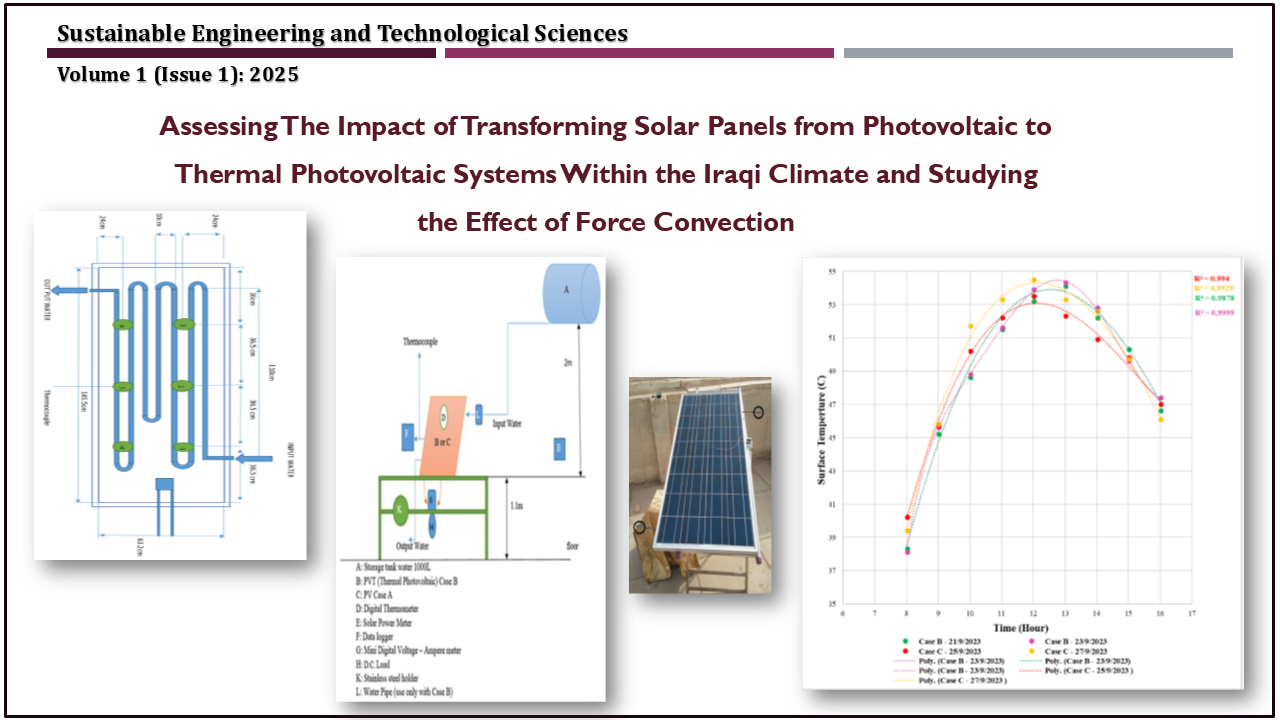Assessing The Impact of Transforming Solar Panels from Photovoltaic to Thermal Photovoltaic Systems Within the Iraqi Climate and Studying the Effect of Force Convection
DOI:
https://doi.org/10.70516/kp7hqx92Keywords:
Solar Panels, Photovoltaic, Thermal Photovoltaic, Iraqi Climate, sustainable energy, electricityAbstract
In the quest to reduce dependence on fossil fuels such as oil, coal and gas, and maximize the use of clean and sustainable energy sources, solar energy stands out as a leading and viable option. This form of energy harnesses electrical energy through solar panels. Over the years, photovoltaic panels have advanced significantly, but they face a major challenge: high operating temperatures. Photovoltaic panels use only a portion of the radiant energy they receive, converting the rest into unwanted heat. This not only reduces their productivity, but also shortens their lifespan. To address this problem and enhance the efficiency of incident radiation energy, thermal photovoltaic panels have been developed. This research indicates that thermal photovoltaic panels generate 3 to 4 watts more electrical energy per hour than conventional photovoltaic panels. In addition, thermal photovoltaic panels maintain lower surface temperatures, being 0.2°C to 2°C cooler than standard photovoltaic panels. This improvement extends to temperatures on the other side of the thermal PV panel and at different locations, especially during the summer. Furthermore, the thermal modules inside the PV panels can increase the temperature of the water passing through them by 3 to 4 degrees Celsius, using only one panel. Experiments involving forced convection on thermal PV panels have shown that while forced convection does not enhance electricity production – in fact, its creation consumes more electricity than it generates, reducing net power production by 1.2 to 27 watts – it does improve thermal efficiency.
Downloads
References
Adams, S., Klobodu, E. K. M., & Apio, A. (2018). Renewable and non-renewable energy, regime type and economic growth. Renewable Energy, 125, 755-767. DOI: https://doi.org/10.1016/j.renene.2018.02.135
Skoplaki, E., & Palyvos, J. A. (2009). On the temperature dependence of photovoltaic module electrical performance: A review of efficiency/power correlations. Solar energy, 83(5), 614-624. DOI: https://doi.org/10.1016/j.solener.2008.10.008
Dupeyrat, P., Ménézo, C., & Fortuin, S. (2014). Study of the thermal and electrical performances of PVT solar hot water system. Energy and Buildings, 68, 751-755. DOI: https://doi.org/10.1016/j.enbuild.2012.09.032
Mustafa K. Ahmed, & Abdul Jabbar N. Khalifa.(2024) . PV and PV/T efficiency enhancement using different materials: A Review. Sigma Journal of Engineering and Natural Sciences Volume 42.

Downloads
Published
Issue
Section
Categories
License
Copyright (c) 2024 Mustafa Ahmed, Abdul Jabbar N. Khalifa (Author)

This work is licensed under a Creative Commons Attribution-NonCommercial-NoDerivatives 4.0 International License.
Open Access and Copyright: SETS operates as an open-access journal, making all its articles freely available to everyone. Published content is licensed under the Creative Commons Attribution International Public License (CC BY 4.0). This license allows individuals and organizations to:
- Download, share, distribute, and print full texts of articles
- Reproduce or link to articles in any medium,
While authors retain copyright for their published work on the SETS website, the journal actively promotes and tracks citations to increase recognition for their research.
In essence, CC-BY-4.0 encourages the widest possible dissemination and utilization of published articles as long as written permission and appropriate credit are given to the authors.







